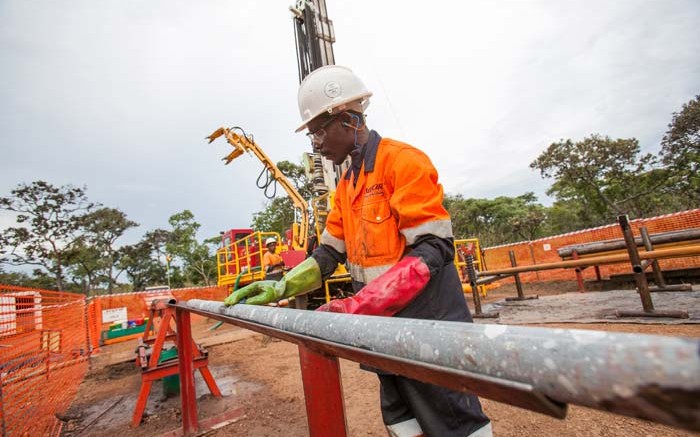VANCOUVER — With a $150-million financing, executive chairman Robert Friedland and his team at Ivanhoe Mines (TSX: IVN; US-OTC: IVPAF) have sidestepped a cash crunch that could have impacted the company’s ability to advance its large-scale Kamoa and Kipushi base-metal assets in the Democratic Republic of the Congo.
On May 20, Ivanhoe struck a bought-deal financing with a group of underwriters led by BMO Capital Markets, CIBC and Macquarie Capital for 83.3 million units priced at $1.50 per unit for gross proceeds of $125 million. Each unit comprises one share and one warrant that allows the holder to buy a share at $1.80 within 18 months. The underwriters also have a 15% over-allotment option.
At the same time, Friedland privately placed $25-million worth of units under the same terms, including the over-allotment option.
Adding the 100 million shares to the existing 584 million shares outstanding is a 17% dilution. Fully diluted, the latest financing represents a 33% increase in shares to 792 million, according to Dundee Capital Markets.
When Ivanhoe released its financial and operating results on May 15, it revealed that it had insufficient capital to complete the next stage of work on its 95%-owned Kamoa copper deposit and 68%-owned Kipushi zinc-copper–germanium–lead mine in the DRC‘s southeast.
The company had reported a consolidated working capital position of US$150 million at the end of March, which would go towards a US$145-million bulk-sampling program at its flagship Platreef platinum group metals (PGM) project on the northern limb of the Bushveld Complex in South Africa.
In the DRC, Kamoa is a newly discovered stratiform copper deposit 25 km east of the mining centre of Kolwezi. Work at Kamoa has focused on initial mine development at the high-grade Kansoko Sud area, where infill drilling has defined a thick, near-surface zone of high-grade copper sulphide mineralization that would be amenable to treatment by conventional copper flotation.
Ivanhoe published a preliminary economic assessment on Kamoa in November 2013, which modelled a US$1.4-billion operation that would produce an average of 300,000 tonnes blister copper annually at cash costs of US$1.19 per lb. Based on US$3 per lb. copper, the proposal carried a US$2.5-billion after-tax net present value at an 8% discount rate, along with a 15.2% internal rate of return.
Ivanhoe has been working on a prefeasibility study (PFS) at Kamoa based on a 3-million-tonne-per-year mine and concentrator that could be split into modules to adjust for underground ramp-up, and potentially control pre-production costs.
Preparations are underway on the first mine-access decline at Kansoko Sud. The decline is designed to provide access to the high-grade resources that would be targeted for the planned first phase of production using a room-and-pillar mining method.
Kamoa features astonishing indicated resources of 739 million tonnes grading 2.67% copper for 43.5 billion contained lb., while inferred resources tack on 227 million tonnes of 1.96% copper for 9.8 billion contained lb. All resource estimates assume a 1% copper cut-off grade.
Kipushi sits along the Central African Copperbelt in the DRC’s Katanga province, 30 km southwest of the provincial capital of Lubumbashi. The zinc mine was placed on care and maintenance in 1993 and flooded in early 2011, due to poor pump maintenance.
Water reportedly reached 851 metres below surface at its peak. Ivanhoe passed a milestone in December 2013 when it restored access to the mine’s principal haulage level at 1,150 metres below the surface.
Ivanhoe’s exploration at Kipushi has focused on copper zones in the Série Récurrente zone from a drill station at the 1,251-metre level.
The company reports that drilling demonstrates “encouraging results,” with the exploration program pegged for expansion. The zone being targeted by the expanded drill program lies below and to the east of historic measured and indicated resources, which globally total 17 million tonnes grading 2.32% copper and 16.76% zinc based on a non-National Instrument 43-101 compliant report filed in 1997.
On May 13 the company announced assay results from an in-fill program at Kansoko Sud that appear to support its plan for a higher-grade mineralization early in Kamoa’s mine life, with hole 860 cutting 17 metres grading 7.04% copper.
Ivanhoe tabled a PEA on Platreef in March that models a phased approach, with development capital pegged at US$1.7 billion for a first-phase operation that would run at 4 million tonnes per year.
Completion of a PFS on the initial phase is slated for the second quarter, with a shaft needed to collect the bulk sample scheduled for the first half of 2016. Ivanhoe reports that it has enough funds to advance Platreef until at least early 2015.
Even with the latest financing, Ivanhoe says it is reviewing its options with respect to its DRC portfolio, including project spin-offs, sales or joint ventures.
BMO Capital Markets analyst Aleksandra Bukacheva reiterated in a May 15 research report that the company’s value proposition remained intact despite it running low on cash, and commended Ivanhoe’s capital-cost reduction strategy. Bukacheva noted that theoretical cash-flow generation for Ivanhoe’s mines was around $1.62 per share in earnings, assuming Platreef, Kamoa and Kipushi hit production.
“In BMO Research’s view, the proposed transaction would increase pure-play appeal of the parts and expand a set of options available to Ivanhoe, with respect to financing and monetizing these assets as stand-alone vehicles,” Bukacheva concluded. “In BMO Research’s opinion, Ivanhoe’s investor base is heavily biased towards ‘platinum’ investors, given the scarcity of platinum-geared investment vehicles. At the same time, arguably the base metals side of Ivanhoe is overlooked, given the wider set of copper and zinc producers and developers.”
Ivanhoe shares were hit hard by the news the company was running low on cash, dropping 16%, or 29¢, to $1.51. After the $150-million financing news, shares dropped again, hit a new multi-year low and traded at $1.39 at press time.


Be the first to comment on "Ivanhoe raises $150M for DRC projects"